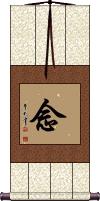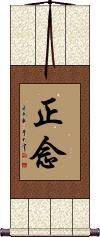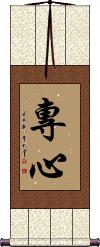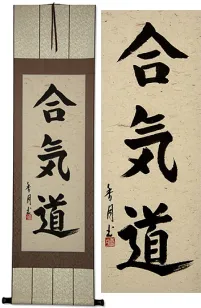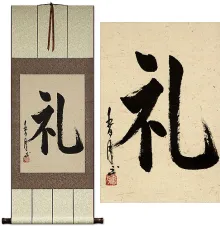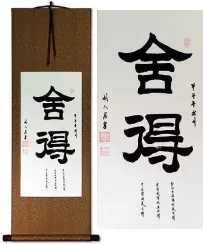Many custom options...
And formats...

Mindfulness in Chinese / Japanese...
Buy a Mindfulness calligraphy wall scroll here!
Personalize your custom “Mindfulness” project by clicking the button next to your favorite “Mindfulness” title below...
Mindfulness
念 is the simplest way to write “mindfulness” in Chinese, Japanese Kanji, and old Korean Hanja.
念 can be defined these ways: To read; to study (a degree course); to read aloud; to miss somebody (keeping them in your mind); idea; remembrance; sense; thought; feeling; desire; concern; attention; recollection; memory; to think on/about; reflect; repeat, intone; a moment.
Obviously, the context in which the character is used determines which definition or meaning is perceived. As a single character, it's open and perhaps ambiguous. Thus, it can be read with any or all of these meanings.
念 is used in a Buddhist context (often written as 正念 or “right mindfulness”) with similar meanings of thought and contemplation.
In Japanese, this character is sometimes used as the name “Nen.”
See Also: Buddhism | Enlightenment
7. Right Mindfulness / Right Memory / Perfect Mindfulness
Samyak Smriti / Samyak Smrti / Samma Sati
正念 is one of the Noble Eightfold Paths of Buddhism. Right Mindfulness, along with Right Effort and Right Concentration, constitute the path to Concentration or Perfect Thought.
Right Mindfulness is about remaining focused on one's body, feelings, mind, and mental qualities. It's also about being ardent, aware, and mindful, and supposes that you've already put aside worldly desire and aversion.
Monk Bhikkhu Bodhi described this as “The mind is deliberately kept at the level of bare attention, a detached observation of what is happening within us and around us in the present moment.” When practicing right mindfulness, the mind is trained to remain in the present, open, quiet, and alert, contemplating the present event.
Another definition: Ongoing mindfulness of body, feelings, thinking, and objects of thought.
This term is exclusively used by devout Buddhists. It is not a common term, and is remains an unknown concept to most Japanese and Chinese people.
See Also: Buddhism | Enlightenment | Noble Eightfold Path
Devotion / Dedication / Attentive / Focused
專心 makes a word that means “paying attention with your heart.”
It's often translated as “dedication,” as in “be absorbed in” or “concentrate one's efforts.” It's also used to mean “with the single mind,” “whole-heartedly,” “paying attention,” “undivided attention,” “concentration (-ed),” “engrossed,” “devotionally (listening/watching),” and/or “attentive.”
The first character means “for a particular person, occasion, or purpose,” “focused on one single thing,” “concentrated,” and sometimes, “special.”
The second character means “heart” or “mind” by itself.
My favorite translation, which comes from the Oxford Advanced Chinese/English Dictionary, is, “wholehearted devotion.”
If it seems like the meaning of this word is quite open, you are correct. The context in which the word is used matters a lot. It can mean different things depending on how you use it. This makes it kind of nice as you can decide what this means to you (within some limits). This is always positive in meaning, so even if a Chinese person reads it differently than you, it will still have a good meaning.
![]() In Japanese, they tend to use a variation of the second character which has one less stroke. If you want your calligraphy written this Japanese form, please click on the Kanji shown to the right instead of the button above. Note: Japanese and Chinese people will recognize either form.
In Japanese, they tend to use a variation of the second character which has one less stroke. If you want your calligraphy written this Japanese form, please click on the Kanji shown to the right instead of the button above. Note: Japanese and Chinese people will recognize either form.
8. Right Concentration / Perfect Concentration
Samyak Samadhi / Samma Samadhi
正定 is one of the Noble Eightfold Paths of Buddhism. Right Concentration, along with Right Effort and Right Mindfulness, constitute the path to Concentration or Perfect Thought.
Right Concentration has to do with leaving behind sensuality, unwholesome states, as well as pleasure and pain. 正定 is a complex idea, but once you have achieved the shedding of worldly sensation, you can truly concentrate and find a higher level of awareness.
Another definition: Concentration of mind that finds its high point in the four absorptions.
This term is exclusively used by devout Buddhists. It is not a common term, and is remains an unknown concept to most Japanese and Chinese people.
See Also: Buddhism | Enlightenment | Noble Eightfold Path
Concentration
Chung shin tong il
精神統一 means concentration of mind or mental concentration in old Korean Hanja and Japanese.
This concentration title is one of the 8 Key Concepts of Tang Soo Do.
You'll often see this romanized from Korean as “Chung Shin Tong Il.”
If you want to order the modern Korean Hangul version, click on the Hangul characters in the pronunciation box. Otherwise, this title is valid Korean Hanja (from the 1600 years that Korea used Chinese characters).
This in-stock artwork might be what you are looking for, and ships right away...
Gallery Price: $200.00
Your Price: $69.88
Not the results for mindfulness that you were looking for?
Below are some entries from our dictionary that may match your mindfulness search...
| Characters If shown, 2nd row is Simp. Chinese |
Pronunciation Romanization |
Simple Dictionary Definition |
念 see styles |
niàn nian4 nien nen ねん |
More info & calligraphy: Mindfulness(1) (esp. 〜の念) sense; idea; thought; feeling; (2) desire; concern; (3) (esp. 念に〜、念の/が〜) attention; care; (personal name) Nen smṛti. Recollection, memory; to think on, reflect; repeat, intone; a thought; a moment. |
正念 see styles |
zhèng niàn zheng4 nian4 cheng nien shounen / shonen しょうねん |
More info & calligraphy: 7. Right Mindfulness / Right Memory / Perfect Mindfulness(1) {Buddh} (See 八正道) right mindfulness; (2) true faith (in rebirth in the promised land); (place-name) Shounen samyak-smṛti, right remembrance, the seventh of the 八正道; 'right mindfullness, the looking on the body and the spirit in such a way as to remain ardent, self-possessed and mindful, having overcome both hankering and dejection. ' Keith. |
八念 see styles |
bā niàn ba1 nian4 pa nien hachinen |
eight kinds of mindfulness |
六念 see styles |
liù niàn liu4 nian4 liu nien rokunen |
(六念法) The six thoughts to dwell upon: Buddha, the Law, the Order, the commands, almsgiving, and heaven with its prospective joys. |
十夜 see styles |
shí yè shi2 ye4 shih yeh tooya とおや |
{Buddh} (See 十夜粥・じゅうやがゆ) ten-night memorial service (6th to 15th days of the 10th month in the lunar calendar); (female given name) Tooya ten nights (of mindfulness of the Buddha) |
四念 see styles |
sì niàn si4 nian4 ssu nien shinen |
four kinds of mindfulness |
大念 see styles |
dà niàn da4 nian4 ta nien dainen |
(大念佛) Invoking Buddha with a loud voice; meditating on Buddha with continuous concentration. |
常念 see styles |
cháng niàn chang2 nian4 ch`ang nien chang nien jounen / jonen じょうねん |
(surname) Jōnen Always remembering; always repeating. |
心念 see styles |
xīn niàn xin1 nian4 hsin nien misato みさと |
(female given name) Misato mindfulness |
念住 see styles |
niàn zhù nian4 zhu4 nien chu nenjū |
base of mindfulness |
念力 see styles |
niàn lì nian4 li4 nien li nenriki ねんりき |
psychokinesis; telekinesis (1) willpower; faith; (2) telekinesis; psychokinesis smṛtibala, one of the five bāla or powers, that of memory. Also one of the seven bodhyaṅga 七菩提分. |
念善 see styles |
niàn shàn nian4 shan4 nien shan nenzen |
mindfulness of goodness |
念天 see styles |
niàn tiān nian4 tian1 nien t`ien nien tien nenten |
One of the six devalokas, that of recollection and desire. |
念失 see styles |
niàn shī nian4 shi1 nien shih nenshitsu |
loss of mindfulness |
念定 see styles |
niàn dìng nian4 ding4 nien ting nenjō |
Correct memory and correct samādhi. |
念心 see styles |
niàn xīn nian4 xin1 nien hsin nenshin |
mindfulness |
念慧 see styles |
niàn huì nian4 hui4 nien hui nen'e |
mindfulness and wisdom |
念戒 see styles |
niàn jiè nian4 jie4 nien chieh nenkai |
mindfulness of morality |
念持 see styles |
niàn chí nian4 chi2 nien ch`ih nien chih nenji |
To apprehend and hold in memory. |
念根 see styles |
niàn gēn nian4 gen1 nien ken nenkon |
smṛtīndriya. The root or organ of memory, one of the five indriya 五根. |
念死 see styles |
niàn sǐ nian4 si3 nien ssu nenshi |
mindfulness of [the inevitability of] death |
念漏 see styles |
niàn lòu nian4 lou4 nien lou nenro |
The leakages; or stream of delusive memory. |
念著 念着 see styles |
niàn zhāo nian4 zhao1 nien chao nenjaku |
Through perverted memory to cling to illusion. |
念處 念处 see styles |
niàn chù nian4 chu4 nien ch`u nien chu nenjo |
smṛtyupasthāna. The presence in the mind of all memories, or the region which is contemplated by memory. |
意思 see styles |
yì si yi4 si5 i ssu ishi いし |
idea; opinion; meaning; wish; desire; interest; fun; token of appreciation, affection etc; CL:個|个[ge4]; to give as a small token; to do something as a gesture of goodwill etc intention; wish; purpose; mind (to do) mindfulness |
憶持 忆持 see styles |
yì chí yi4 chi2 i ch`ih i chih okuji |
To keep in mind, to remember and maintain. |
攝念 摄念 see styles |
shè niàn she4 nian4 she nien shōnen |
gathering mindfulness |
護念 护念 see styles |
hù niàn hu4 nian4 hu nien gonen |
To guard and care for, protect and keep in mind. |
讃歎 see styles |
sandan さんだん santan さんたん |
(noun/participle) (1) (Buddhist term) praising Buddha; sermon; (2) (Buddhist term) praise (second of the five gates of mindfulness); (3) (Buddhist term) style of Buddhistic song of praise, usually praising Buddha, the Bodhisattva, the Buddhistic teachings, etc.; (4) (archaism) rumor; rumour; hearsay; (n,vs,adj-no) praise; extolment; extollment |
讃談 see styles |
sandan さんだん |
(noun/participle) (1) (Buddhist term) praising Buddha; sermon; (2) (Buddhist term) praise (second of the five gates of mindfulness); (3) (Buddhist term) style of Buddhistic song of praise, usually praising Buddha, the Bodhisattva, the Buddhistic teachings, etc.; (4) (archaism) rumor; rumour; hearsay |
Click here for more mindfulness results from our dictionary
The following table may be helpful for those studying Chinese or Japanese...
| Title | Characters | Romaji (Romanized Japanese) | Various forms of Romanized Chinese | |
| Mindfulness | 念 | nen | niàn / nian4 / nian | nien |
| 7. Right Mindfulness Right Memory Perfect Mindfulness | 正念 | sei nen / seinen | zhèng niàn zheng4 nian4 zheng nian zhengnian | cheng nien chengnien |
| Devotion Dedication Attentive Focused | 專心 / 専心 / 耑心 专心 | sen shin / senshin | zhuān xīn zhuan1 xin1 zhuan xin zhuanxin | chuan hsin chuanhsin |
| 8. Right Concentration Perfect Concentration | 正定 | sei jou / seijou / sei jo | zhèng dìng zheng4 ding4 zheng ding zhengding | cheng ting chengting |
| Concentration | 精神統一 | seishintouitsu seishintoitsu | ||
| In some entries above you will see that characters have different versions above and below a line. In these cases, the characters above the line are Traditional Chinese, while the ones below are Simplified Chinese. | ||||
Successful Chinese Character and Japanese Kanji calligraphy searches within the last few hours...
